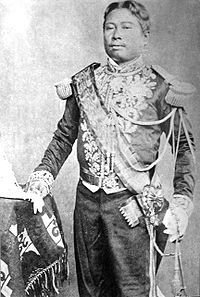Main articles: French Protectorate of Cambodia and French Indochina
French Indochina in 1913.
During World War II, the 1940–41 Franco-Thai War left the French Indochinese colonial authorities in a position of weakness. The Vichy government signed an agreement with Japan to allow the Japanese military transit through French Indochina.[112]
Meanwhile the Thai government, under the pro-Japanese leadership of Field Marshal Plaek Phibunsongkhram, took advantage of its position and invaded Cambodia's western provinces.[113]
Cambodia's situation at the end of the war was chaotic. The Free French, under General Charles de Gaulle, were determined to recover Indochina, though they offered Cambodia and the other Indochinese protectorates a carefully circumscribed measure of self-government. Convinced that they had a "civilizing mission", they envisioned Indochina's participation in a French Union of former colonies that shared the common experience of French culture.
Administration of Sihanouk (1953–70)
Main articles: Japanese occupation of Cambodia and Kingdom of Cambodia (1953–70)
On 9 March 1945, during the Japanese occupation of Cambodia, young king Norodom Sihanouk
proclaimed an independent Kingdom of Kampuchea, following a formal
request by the Japanese. Shortly thereafter the Japanese government
nominally ratified the independence of Cambodia and established a
consulate in Phnom Penh.[114] The new government did away with the romanisation of the Khmer language that the French colonial administration was beginning to enforce and officially reinstated the Khmer script.
This measure taken by the short-lived governmental authority would be
popular and long-lasting, for since then no government in Cambodia has
tried to romanise the Khmer language again.[115]
After Allied military units entered Cambodia, the Japanese military
forces present in the country were disarmed and repatriated. The French
were able to reimpose the colonial administration in Phnom Penh in
October the same year.[116]Sihanouk's "royal crusade for independence" resulted in grudging French acquiescence to his demands for a transfer of sovereignty. A partial agreement was struck in October 1953. Sihanouk then declared that independence had been achieved and returned in triumph to Phnom Penh. As a result of the Geneva Conference on Indochina, Cambodia was able to bring about the withdrawal of the Viet Minh troops from its territory and to withstand any residual impingement upon its sovereignty by external powers.
Neutrality was the central element of Cambodian foreign policy during the 1950s and 1960s. By the mid-1960s, parts of Cambodia's eastern provinces were serving as bases for North Vietnamese Army and National Liberation Front (NVA/NLF) forces operating against South Vietnam, and the port of Sihanoukville was being used to supply them. As NVA/VC activity grew, the United States and South Vietnam became concerned, and in 1969, the United States began a 14-month-long series of bombing raids targeted at NVA/VC elements, contributing to destabilisation. The bombing campaign took place no further than ten, and later twenty miles (32 km) inside the Cambodian border, areas where the Cambodian population had been evicted by the NVA.[117] Prince Sihanouk, fearing that the conflict between communist North Vietnam and South Vietnam might spill over to Cambodia, publicly opposed the idea of a bombing campaign by the United States along the Vietnam–Cambodia border and inside Cambodian territory. However Peter Rodman claimed, "Prince Sihanouk complained bitterly to us about these North Vietnamese bases in his country and invited us to attack them". In December 1967 Washington Post journalist Stanley Karnow was told by Sihanouk that if the US wanted to bomb the Vietnamese communist sanctuaries, he would not object, unless Cambodians were killed.[118] The same message was conveyed to US President Johnson's emissary Chester Bowles in January 1968.[119] So the US had no real motivation to overthrow Sihanouk. However Prince Sihanouk wanted Cambodia to stay out of the North Vietnam–South Vietnam conflict and was very critical of the United States government and its allies (the South Vietnamese government). Prince Sihanouk, facing internal struggles of his own, due to the rise of the Khmer Rouge, did not want Cambodia to be involved in the conflict. Sihanouk wanted the United States and its allies (South Vietnam) to keep the war away from the Cambodian border. Sihanouk did not allow the United States to use Cambodian air space and airports for military purposes. This upset the United States greatly and contributed to their view that of Prince Sihanouk as a North Vietnamese sympathiser and a thorn on the United States.[120] However, declassified documents indicate that, as late as March 1970, the Nixon administration was hoping to garner "friendly relations" with Sihanouk.
Throughout the 1960s, domestic Cambodian politics became polarised. Opposition to the government grew within the middle class and leftists including Paris-educated leaders like Son Sen, Ieng Sary, and Saloth Sar (later known as Pol Pot), who led an insurgency under the clandestine Communist Party of Kampuchea (CPK). Sihanouk called these insurgents the Khmer Rouge, literally the "Red Khmer". But the 1966 national assembly elections showed a significant swing to the right, and General Lon Nol formed a new government, which lasted until 1967. During 1968 and 1969, the insurgency worsened. However members of the government and army, who resented Sihanouk's ruling style as well as his tilt away from the United States, did have a motivation to overthrow him.


No comments:
Post a Comment